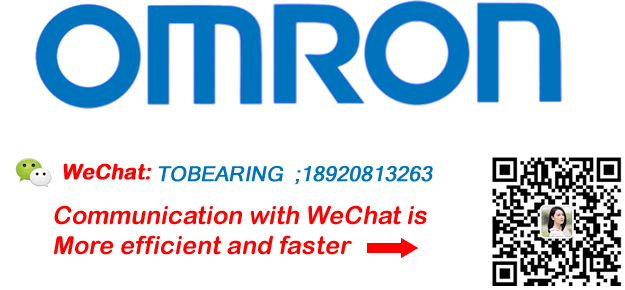
OMRON ZUV SeriesPower Supplies / In Addition/ UV-Light Curing Systems/ Copyright Statement
Copyright Statement
OMRON ZUV Series Power Supplies / In Addition
- ZUV Series Smart Curing System (Standard model/Multi-function model)/Catalog
- ZUV Series Smart Curing System (Standard model/Multi-function model)/Dimensions
- ZUV Series Smart Curing System (Standard model/Multi-function model)/Lineup
- ZUV Series Smart Curing System (Standard model/Multi-function model)/Specifications
- Purchase the OMRON ZUV Series
 Copyright Statement
Copyright Statement
OMRON ZUV Series Dimensions
/Images/l_1876-25-119104-198x198.jpglast update: December 14, 2016
ZUV value model
[Value Model Controller] × [Value Model Head]
Cost performance that will overwhelm a lamp system
Achieves a low initial cost level believed to be impossible in an LED system up to now.
ZUV value model has made sweeping cost reductions possible at an initial cost lower than a lamp system.
The cost revolution was made possible by OMRON’s extensive track record in lamp system replacement and LED system introduction.
There's no mistaking it. It's an LED era from now on.

Initial cost efficiency

The basic performance of UV bonding is retained while significant cost savings compared to a conventional LED system is achieved with carefully selected features.
ZUV value model can be purchased at a price below that of the lamp system.
Beats lamp replacement costs

If customers who are currently using a lamp system would compare the costs of lamp replacement, which occurs about three times a year, in cases where they would continuously use a lamp system for two years from now on they would find installing the ZUV value model less expensive.
*1. Comparing the case in which you keep using a lamp system with the case where you switch to the ZUV value model
*2. Lamp replacement costs after two years have gone by at a replacement frequency of about three times a year
Running costs is severely reduced.
It is characteristic of the LED to have a longer life in comparison with a lamp system.
For that reason, extended use over a long period of time is possible and exchange frequency will decrease. In addition, LED system, with its highly stable light source, can be turned off when illumination is not needed. So, electricity costs can be reduced.
(For a lamp system whose light source is unstable, you have to leave its light source on all the time.)
OMRON’s unique head technology
It is a UV-LED, whose characteristic is its long life, but there is a chance that its life will be shorter if the heat is not properly dissipated when emitting light. For that reason, it is considered necessary to avoid rises in temperature during illumination. The advance that has fulfilled this requirement in a compact head is OMRON’s unique heat dissipation structure = the Smart Canyon.
Optimized "New Smart Canyon Structure"

The Smart Canyon structure has been utilized in all heads in the ZUV Series, but for the sake of achieving low initial cost in the value model heads we have optimized this Smart Canyon structure even further, enabling it to dissipate heat more efficiently.
Solve various problems of lamp system
Eliminates the manpower, time, and costs of light source replacement
Industry’s top-class lifetime of 40,000 hours achieved with ultra cooling heads

The biggest issue for the lamp system is frequent replacement of the lamp light source.
LED system has longer life compared to the lamp system. Replacement man hours can also be eliminated if you use the ultra cooling head. The continuously-on lifetime of the ultra cooling head is 40,000 hours, both the labor hours and running costs of the replacement work can be reduced substantially.

As for the ultra cooling head, we have expanded the number of heat dissipating ribs in the Smart Canyon Structure from 21 of standard head (ZUV-H30MC) to 40 by making the housing into a long body. Through effective dissipation of heat, we have achieved industry-leading long life and illuminance stability.
Even shorter tact time with new UV LEDs
High-speed bonding with the highest illumination class in the industry at 13,200 mW/cm2 produced by an ultra light focus lens
New UV LEDs with much greater brightness are used on all heads.
If you mount an ultra light focus lens, the illumination greatly exceeds the average illumination of mercury lamps to achieve the industry’s top class at 13,200 mW/cm2. This represents an approximately 140% increase in illumination over previous heads so that you can reduce bonding tact times even more. *3
*3 Typical example with ultra light focus lens ZUV-L2H

As the number of channels is increased by branching fibers, the maximum illumination for a lamp system continues to decrease. With an LED system, the maximum illumination of each head remains the same regardless of how many channels are used, to enable highly productive UV bonding.

Uses UIT-150 UV Light Integrating Actinometer manufactured by Ushio Inc.
When measured at suggested work distance.
Lamp system value is an example with a typical fiber.
Environmentally safe
Substantially reduces CO2 emissions in power-saving LED system usage
High power consumption and disposal of the mercury lamps that occurs with each replacement are problems at a lamp system site, but they can be resolved by using an LED system. An LED system has lower power consumption than a mercury lamp system, and can also lead to power saving with efficient use of energy through lighting control. It contributes to reduce CO2 emissions substantially. In addition, the LED light source doesn’t use mercury so it is superior in terms of reduced environmental impact.

* Standard model controller ZUV-C20H
Notes:
Assumed to be 24 hours and 260 days operation.
Assumes "on time divided by equipment operation time" to equal one-third.
For CO2 emissions, calculation of 4.1t CO2 reduction with 10,000 kWh reduction in the Nationwide Receiving End Coefficient published by the Federation of Electric Power Companies of Japan
Power consumption may vary according to device conditions
last update: December 14, 2016
Purchase the OMRON  Copyright Statement Please fill in the following
Copyright Statement Please fill in the following
If you have just landed here, this product OMRON ZUV Series Power Supplies / In Addition,Power Supplies / In Addition is offered online by Tianin FLD Technical Co.,Ltd. This is an online store providing Power Supplies / In Addition at wholesale prices for consumers. You can call us or send enquiry, we would give you the prices, packing,deliverty and more detailed information on the ZUV Series We cooperate with DHL,TNT,FEDEX,UPS,EMS,etc.They guarantee to meet your needs in terms of time and money,even if you need your OMRON ZUV SeriesPower Supplies / In Addition tomorrow morning (aka overnight or next day air) on your desk, 2, 3 days or more.Note to international customers, YES, we ship worldwide.
G70R-SOC08 Relay Terminal/Features
ZJ-BAS Ionizer (Digital Bar Type)/Features
E52 with Ferrule (Exclusive Models) Temperature Sensor with Ferrule (Exclusive Models)/Features
V680S Series RFID System/Features
K8AK-AW Single-phase Overcurrent/Undercurrent Relay/Features
OMRON ZUV Series catalog
ZUV Series Smart Curing System (Standard model/Multi-function model)/Catalog- Catalog
- Manual
- CAD
English
Global Edition
| Catalog Name | Catalog Number [size] | Last Update | |
|---|---|---|---|
| | - [1477KB] | Dec 14, 201620161214 | ZUV Series Data Sheet |
| | E364-E1-04 [2511KB] | Dec 14, 201620161214 | ZUV Series Catalog |
OMRON ZUV Series dimension
ZUV Series Smart Curing System (Standard model/Multi-function model)/Dimensionslast update: September 12, 2013
Controller
Value model ZUV-C20H
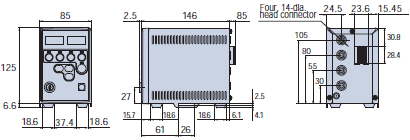
Multi-function model ZUV-C30H

Head Unit
Standard head (When attached to spot lens)
Value model ZUV-H20MC

ZUV-H30MC

Ultra cooling head
ZUV-H10MC

Diffuse illumination head (When attached to ZUV-L12H)
Value model ZUV-H25MC

ZUV-H35MC

Mounting Bracket
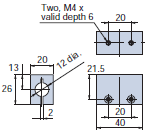
Lens Unit
Spot lens ZUV-L3H/L4H/L6H/L8H/L10H
Note: The model number is printed on the side of the Lens unit.

Ultra light focus lens ZUV-L2H
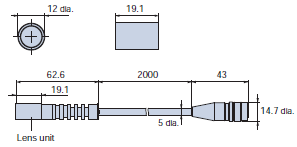
Note: When attached to ZUV-H20MC (Standard head value model)
Line beam lens ZUV-L12L

Note: When attached to ZUV-H20MC (Standard head value model)
ZUV-L15L
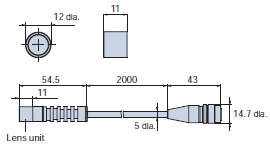
Note: When attached to ZUV-H25MC (Diffuse illumination head value model)
Side-view lens ZUV-L[]S
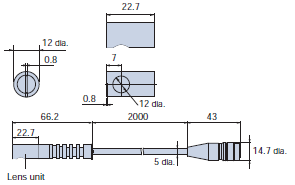
Note: The model number is printed on the side of the lens unit.
Note: When attached to ZUV-H20MC (Standard head value model)
Diffusing lens ZUV-L12H
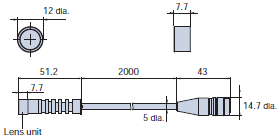
Note: When attached to ZUV-H25MC (Diffuse illumination head value model)
last update: September 12, 2013
OMRON ZUV Series lineup
ZUV Series Smart Curing System (Standard model/Multi-function model)/Lineuplast update: May 21, 2014
Controller
| Type | Model |
|---|---|
| Value model | ZUV-C20H |
| Multi-function model | ZUV-C30H |
Head Unit *
| Type | Cable length | Model | |
|---|---|---|---|
| Standard head | Value model | 2 m | ZUV-H20MC 2M |
| - | 0.3 m | ZUV-H30MC 0.3M | |
| Ultra cooling head | 0.3 m | ZUV-H10MC 0.3M | |
| 2 m | ZUV-H10MC 2M | ||
| Diffuse illumination head | Value model | 2 m | ZUV-H25MC 2M |
| - | 0.3 m | ZUV-H35MC 0.3M | |
* 365 - nm light source wavelength. Models are also available with a 385-nm light source wavelength.
(Standard head: ZUV-H21MC 2M/H11MC 2M, diffuse illumination head: ZUV-H26MC 2M)
Lens Unit
| Type | Spot | Model |
|---|---|---|
| Spot lens | Spot dia.: 3 mm | ZUV-L3H |
| Spot dia.: 4 mm | ZUV-L4H | |
| Spot dia.: 6 mm | ZUV-L6H | |
| Spot dia.: 8 mm | ZUV-L8H | |
| Spot dia.: 10 mm | ZUV-L10H | |
| Ultra light focus lens | Spot dia.: 2 mm | ZUV-L2H |
| Line beam lens | Beam width: 12 mm | ZUV-L12L |
| Beam width: 15 mm | ZUV-L15L | |
| Side-view lens * | Spot dia.: 3 mm | ZUV-L3S |
| Spot dia.: 4 mm | ZUV-L4S | |
| Spot dia.: 6 mm | ZUV-L6S | |
| Spot dia.: 8 mm | ZUV-L8S | |
| Spot dia.: 10 mm | ZUV-L10S | |
| Diffusing lens (for diffuse illumination head) | Spot dia.: 12 mm | ZUV-L12H |
* When using ZUV-H25MC/H35MC diffuse illumination head with side-view lens, we recommend using ZUV-L3S/L4S.
For Extending Length between Controller and Heads
| Type | Cable length | Model |
|---|---|---|
| Extension cable | 2 m | ZUV-XC2B |
| 5 m | ZUV-XC5B | |
| 10 m | ZUV-XC10B |
last update: May 21, 2014
OMRON ZUV Series specification
ZUV Series Smart Curing System (Standard model/Multi-function model)/Specificationslast update: December 14, 2016
Controller
| Model | ZUV-C20H (Value model) | ZUV-C30H (Multi-function model) | |
|---|---|---|---|
| Irradiation method | Constant irradiation | Irradiation power (0% to100%), Irradiation time (max. 99.9 s/unlimited) | Irradiation power (0% to 100%), Irradiation time (999.9 s max./unlimited) |
| Pattern irradiation | Unavailable | Can be set to step or ramp (linear) 16 points specified per setting) Applicable Heads: ZUV-H Series | |
| No. of settings | No bank feature | 16 banks | |
| Cumulative Irradiation | Time (unit: 100 hour display) | Energy (display unit - J) | |
| Terminal block I/O | Inputs | Emergency stop, UV illumination start/stop (all channels/4 channels) | Emergency stop, start/stop UV irradiation (4 channels), select settings (banks) |
| Outputs | Ready (all channels/4 channels), error, operating life | Ready (4 channels), UV irradiating, errors | |
| RS-232C and USB I/O | None | Start/stop UV irradiation (4 channels), select settings (banks), get/change settings data, save/read data, power tuning | |
| Cooling method | Natural air cooling (no fan) | Natural air cooling | |
| Power supply voltage | 100 to 240 V AC±10% 50/60 Hz (In the case of using AC adapter) *1 *2 19 V DC±5% *3 | Select AC or DC power supply AC power supply: 100 to 240 V AC±10%, 50/60 Hz (AC adapter included) *1 *4 DC power supply: 24 V DC±10% (supplied from terminal block on back of unit) | |
| Current consumption | 1.4A (53W) | • With AC adapter: 1.5 A (36VA) • With DC power supply: 1.5 A (36VA) | |
| Vibration resistance | 10 to 150 Hz (acceleration 50 m/s2) with a 0.35 mm single amplitude for 8 minutes each in X, Y, and Z directions, 10 times | ||
| Shock resistance | 150 m/s2 in 6 directions (up/down, right/left, front/back), 3 times each | ||
| Ambient temperature range | Operating: 5 to 35°C; Storage: -10 to 60°C (with no condensation or icing) | ||
| Ambient humidity range | Operating/storage: 30% to 85% (with no condensation or icing) | ||
| Degree of protection | IEC 60529 IP20 | ||
| Material | Polycarbonate, SECC | SUS, aluminum | |
| Weight (package state) | Approx. 1,800g (Controller: approx. 1,200g) | Approx. 2,600g (Controller: approx. 1,800g) | |
| Accessories | Instruction sheet, key, AC adapter | Instruction sheet, key, AC adapter | |
*1. Attached AC cord as standard is designed for use with 100 V AC (Japanese specifications).
*2. When ZUV is used in China, ZUV-C20H-Z1 should be selected. AC cord for use with 220 V AC (Chinese specifications)
is in it.
*3. When ZUV is used in any other country, ZUV-C20H-D1 should be selected.
AC adapter and AC cord is not supplied with it, but the cord for DC input is supplied.
*4. In the case that you use ZUV-C30H in other than Japan, please connect DC power supply to terminal on backside.
Head Unit
| Model | ZUV-H20MC/H30MC/H10MC/H25MC/H35MC | |
|---|---|---|
| Light source | Wavelength | 365nm * |
| Class | Class 3B (JIS C 6802: 2005) Class 3B (EN60825-1: 1994 +A1: 2002 +A2: 2001) | |
| Vibration resistance | 10 to 150 Hz (acceleration 50 m/s2) with a 0.35 mm single amplitude for 8 minutes each in X, Y, and Z directions, 10 times | |
| Shock resistance | 150 m/s2 in 6 directions (up/down, right/left, front/back), 3 times each | |
| Ambient temperature range | Operating: 5 to 35°C; Storage: -10 to 60°C (with no condensation or icing) | |
| Ambient humidity range | Operating/storage: 30% to 85% (with no condensation or icing) | |
| Degree of Protection | IEC60529 IP40 | |
| Material | ZUV-H20MC/25MC: Zinc, aluminum, glass ZUV-H30MC/H10MC/H35MC: Zinc, copper, aluminum, glass | |
| Weight (packed state) | ZUV-H20MC/H25MC: Approx. 185g (Head unit: approx. 100g), ZUV-H30MC/H35MC: Approx. 150g (Head unit: approx. 55g), ZUV-H10MC 0.3M: Approx. 180g (Head unit:approx. 105g), ZUV-H10MC 2M: Approx. 235g (Head unit:approx. 160g) | |
| Accessories | Instruction sheet, mounting brackets (with M3 screws), warning labels (in English) | |
* Models are also available with a 385-nm light source wavelength. (Standard head:ZUV-H21MC 2M/H11MC 2M, diffuse
illmination head:ZUV-H26MC 2M)
Lens Unit
| Model | ZUV-L2H/L3H/L4H/L6H/L8H/L10H/L12L/L15L/L3S/L4S/L6S/L8S/L10S/L12H |
|---|---|
| Vibration resistance | 10 to 150 Hz (acceleration 50 m/s2) with a 0.35 mm single amplitude for 8 minutes each in X, Y, and Z directions, 10 times |
| Shock resistance | 150 m/s2, 6 directions (up/down, right/left, front/back), 3 times each |
| Ambient temperature range | Operating: 5 to 35°C; Storage: -10 to 60°C (with no condensation or icing) |
| Ambient humidity range | Operating/storage: 30% to 85% (with no condensation or icing) |
| Degree of Protection | IEC60529 IP40 |
| Material | Aluminum, glass |
| Weight (package) | ZUV-L2H/L3H/L4H/L6H/L8H/L10H: Approx. 10g (lens unit: approx. 5g), ZUV-L12L/L15L: Approx. 30g (lens unit: approx. 5g), ZUV-L3S/L4S/L6S/L8S/L10S: Approx. 35g (lens unit: approx. 5g), ZUV-L12H: Approx. 30g (lens unit: approx. 5g) |
| Accessories | Instruction sheet |
When using the standard head
Ultra light focus lens/Spot lens/Line beam lens
| Head unit model | ZUV-H20MC/H30MC/H10MC | ||||||
|---|---|---|---|---|---|---|---|
| Lens unit model | ZUV-L2H | ZUV-L3H | ZUV-L4H | ZUV-L6H | ZUV-L8H | ZUV-L10H | ZUV-L12L |
| Spot diameter/Beam shape | 2 dia. | 3 dia. | 4 dia. | 6 dia. | 8 dia. | 10 dia. | 12 ✕ 2mm |
| Recommended working distance | 10mm | 10mm | 15mm | 20mm | 20mm | 30mm | 15mm |
| Peak illumination *1 | 13,200 mW/cm2 | 8,600 mW/cm2 | 7,200 mW/cm2 | 4,500 mW/cm2 | 2,200 mW/cm2 | 760 mW/cm2 | 1,500 mW/cm2 |
Side-view lens
| Head unit model | ZUV-H20MC/H30MC/H10MC | ||||
|---|---|---|---|---|---|
| Lens unit model | ZUV-L3S | ZUV-L4S | ZUV-L6S | ZUV-L8S | ZUV-L10S |
| Spot diameter | 3 dia. | 4 dia. | 6 dia. | 8 dia. | 10 dia. |
| Recommended working distance | 4mm | 5mm | 8mm | 13mm | 5mm |
| Peak illumination *1 | 8,300mW/cm2 | 6,400mW/cm2 | 4,200mW/cm2 | 2,100mW/cm2 | 660mW/cm2 |
When using the diffuse Illmination head
Diffusing lens/Side-view lens/Line Beam lens
| Head unit model | ZUV-H25MC/H35MC | |||
|---|---|---|---|---|
| Lens unit model | ZUV-L12H | ZUV-L3S | ZUV-L4S | ZUV-L15L |
| Spot diameter/Beam shape | 12 dia. | 3 dia. | 4 dia. | 1.5 ✕ 3mm |
| Reco mmended working distance | 30mm | 8mm | 13mm | 15mm |
| Peak illumination *1 | 1,100mW/cm2 | 5,400mW/cm2 | 3,000mW/cm2 | 770mW/cm2 |
*1 Under the following conditions: 100% irradiation power, 25°C room temperature, and with heat sink. Values for
reference only.
The illumination varies depending on factors such as the amiant environment, installation conditions, the service life
of part, and differences between parts.
Continually check the curing status to ensure that there is room for error in the illumination.
Refer to Beam Spot Profiles (Typical Examples) on catalog for design information.
last update: December 14, 2016
- NO. ZUV Series
- TYPE:UV-Light Curing Systems
 Copyright Statement
Copyright Statement  Copyright Statement
Copyright Statement - DATE:2021-06-07
- Associated products:
R87B Box Fan/Features ZJ-FW Fan Ionizer (Area fan type)/Features